| The Book Chapters | |
|
This book is for all with exquisite taste for multilayered European cakes; bakers or non-bakers. The book takes a minimalistic approach so that even the most modestly equipped kitchens can serve as artistic studios for creating
these culinary masterpieces.
A brief description introduces each cake, followed by a short story relating to the cake or its name. It may be an interesting piece of history, or just my favorite personal recollections from growing up in a rich tradition of home baking. All recipes are self-contained, independent and complete. The book closes with a thoroughly researched section on history which follows the usage of various cake ingredients since the time they entered human diet to the present. It views the history of cakes as an ongoing human quest for luxury and indulgence. |
|
|
* Cakes whose original recipes are not gluten-free but which can easily be made gluten-free without any change in taste or structure
** Gluten-free cakes |
|
|
|
|
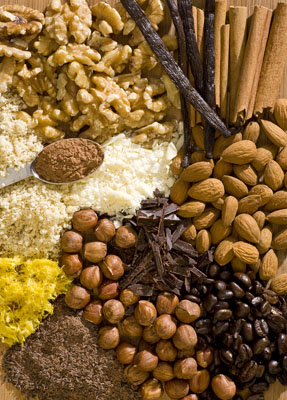
|
About the recipes
This introductory chapter covers the necessary techniques and basic equipment required to execute the recipes. For complicated procedures, the reader is directed to the section titled "Basic Procedures and Common Mistakes". Armed with thorough explanations and step-by-step illustrations, even novices can learn new procedures and successfully execute even the most complicated recipes with results that will please even the most demanding palate. |
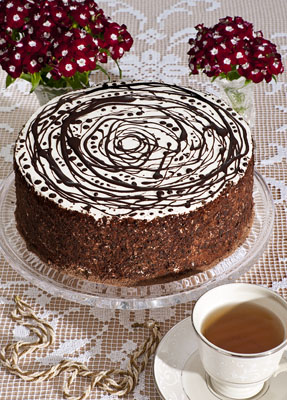
|
Meringue Cake*
This is a rich cake because of all the walnuts in its thick, delicious pastry cream filling. Yet, it is very delicately balanced with a soft meringue layer below and a layer of lightly sweetened whipped cream on top. A hint of chocolate shavings used for decoration will give it just the right finishing touch. This cake will impress a crowd, yet it is very easy to make. The thick meringue layer requires some time to bake and cool, but the actual work on the whole cake amounts to less than an hour. This was my uncle’s favorite cake. He loved it almost as much as he loved talking, and he never missed an opportunity to combine the two pleasures. |

|
Coconut Cake
This cake consists of three thick layers: the bottom layer is made of lemon flavored coconut dough, the middle layer is made of vanilla flavored pastry cream, and the top layer is made of whipped cream. It has a bolder coconut flavor and is less moist than the more delicate and airy Lemon Coconut Cake described in this book. I adjusted the amount of sugar according to the taste of my eldest daughter, who adores this cake, and frequently asks for it. Her wish usually comes true, since this cake is very easy to make. |

|
Slovenian Walnut Cake**
This is my Slovenian friend Tanya’s favorite childhood cake, and the comfort food recipe of today. It is made with two layers and a thick layer of rich apricot preserves between them. The cake layers, apart from their hearty walnut taste, have a subtle cinnamon aroma which deliciously complements the taste of apricots. Apricot preserve, on the other hand, adds just the right amount of moisture and a hint of sourness to the combination. This cake is fast and easy to make today with readily available shelled walnuts. But it was quite different in the 19th century Slovenia, where cakes like this one originated. It was the prosperous time after the Napoleonic expansion that brought many progressive changes to the Slovenian society. |

|
Sacher Torte
The title of the most famous cake in the world easily goes to Sachetorte. It is rich and moist, not overly sweet, and has a very deep and delicious chocolate flavor. It consists of two thick, dense cake layers joined with a layer of apricot preserve. Simple elegance of the chocolate glaze gives it a distinctive and sophisticated look. The original chocolate glaze for the Sachertorte is very sweet and hard, because it is made of half sugar syrup and half chocolate. It is also more difficult to make and spread over the cake than the glaze in the recipe I give. But the main reason I changed the recipe is because I personally have not met anyone who prefers the ultrasweet taste of the original glaze. But, historically speaking, Sacher chocolate glaze was the only truly novel component of this cake, and the reason why Sachertorte was so different from other chocolate cakes of the time. |

|
Madame de Pompadour Torte*
Sincere and tender Pompadour As I would like to give you in advance This name, which rhymes with Amour And soon will be the most beautiful in France ~ Voltaire ~ Despite her humble origins, Madame de Pompadour rose to prominence relying on her intelligence, beauty, and strong personal qualities. Origins of this cake may be as humble, but it is rich, elegant and delicious. This cake has soft chocolate sponge cake layers filled with hearty buttercream bursting with finely grated walnuts. This cake is as magnificent as the person whose name it bares. |

|
Schwarzwalder Kirschtorte*
The lands surrounding the entire length of the River Danube are very favorable for the growth of sour cherry trees. Not surprisingly, sour cherries found their way in many recipes. This particularly pleasing combination of flavors provided by chocolate, whipped cream, and sour cherries, that became a timeless classic, is very typical of many desserts and cakes, including the most famous of them all, the Black Forest Cake. Although similar cakes were made earlier, the first written recipe dates from the 1930s. By the 1950s, the Black Forest Cake became world-renowned. It is made of chocolate sponge cake layers filled with tart cherries and whipped cream. The whole cake is then covered with whipped cream and chocolate shavings. Cake layers are sprinkled with cherry brandy (Kirschwasser), but omitting this step results in an equally delicious, alcohol-free version. |

|
Pavlova*
This is a refreshing and especially light cake. The bottom layer is made of a thick and soft meringue which practically melts in the mouth. It is covered with a layer of fresh raspberries. Vanilla pastry cream is used for the top layer, and the whole cake is then covered with whipped cream. If layers are placed in different order, with fruit on the top, this cake becomes the world-famous pavlova, national dessert of Australia and New Zealand. Both Australia and New Zealand lay claims on the invention of the pavlova cake, and this trans-Tasman rivalry is still as steamy as ever. The Oxford English Dictionary, in its quest to trace the origins of all the words in English language, also got mixed up in the dispute. In December 2010, it revealed in its online edition that the first recipe with the name “pavlova” was recorded in 1927 in Davis Dainty Dishes, published by the Davis Gelatine company of New Zealand. Australian cooks were outraged. |

|
White Cake With Seasonal Fruit
This cake is made with basic sponge cake layers, filled with fresh fruit and vanilla-flavored pastry cream. It is very light, and not too sweet, especially if the fruit is a bit tart. This was the most frequent birthday cake among my childhood friends. Different versions included different seasonal fruits, but strawberries and blueberries were the most popular. Since many of my friends had winter birthdays, oranges and bananas were favorites, too. My little brother, on the other hand, had a summer birthday, and mother liked to make his birthday cake with blackberries, which also provided the contrasting dark-blue hue he liked. |

|
Strawberry Cake*
This is my favorite fruit-based cake: refreshing, light, soft, with creamy vanilla filling and fresh fruit. It is made of basic savoy sponge cake layers, and a heavenly version of vanilla pastry cream combined with Italian meringue. Whipped cream covers the entire cake. |

|
Lemon Coconut Torte*
Refreshing, light, and delicious, this is another one of my favorite cakes. It contains airy and light meringue layers with finely grated coconut and a zest of lemon. It is filled with lemon-flavored pastry cream. I got this recipe from my mother’s Hungarian friend and neighbor Erzsebet Kaszas. She uses the same recipe to make incredible little cookies which she calls “coconut kisses”. They can best be described as an extremely light version of coconut macaroons, sandwiched with lemon-flavored pastry cream. Both the cake and the cookies have the same delicious, melt-in-the-mouth taste. |
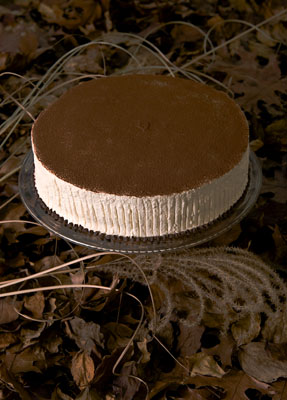
|
Baiser Torte*
Coffee with whipped cream? I haven’t met anybody who wasn’t impressed with this cake. Between its thin, soft meringue layers are very thin layers of wonderful coffee buttercream. All is covered with lightly sweetened whipped cream. The three parts are so perfectly balanced, that the cake is very light, not too sweet, and simply delicious. “Baiser” means kissing in French, so the cake may also be called “The Cake of Kisses”. This is the same basic meringue recipe used for the little melt-in-the-mouth meringue cookies, also known as “meringue kisses” or “forgotten kisses”. The word “forgotten” refers to the way they are baked – after the initial baking in a warm oven, the oven is turned off, and the cookies are left inside (or forgotten) to dry out overnight. |

|
Delicious Cake**
This cake consists of dense walnut sponge cake layers spiced with a hint of coffee, and filled with chocolate French buttercream. These basic tastes naturally blend into an exceptionally balanced flavor. As the name says – it is simply delicious! Once you put the effort into making this exquisite cake, it does make sense to add a little extra time for decoration. For buttercream cakes, I like to use buttercream decoration. Buttercream decoration is applied directly on the cake, using a pastry bag fitted with different tip attachments. |

|
Coffee Torte*
Heavenly coffee buttercream filling of this cake, with slightly dense and moist walnut sponge cake layers, deliciously spiced with coffee and lemon zest, form a combination perfect for coffee lovers. This is a family recipe of my friend Ada Dejeu, originally from Timişoara, Romania. Timişoara was the most important cultural centers of the Austro-Hugarian Empire east of Vienna. Many buildings in the old city, founded in the 17th and 18th century and built in baroque style and later in Vienna secession style of the 19th century, are reminiscent of the old Vienna. That’s why the city is also called “Little Vienna”. Strong, unfiltered black coffee, the same way it was served in the first coffeehouses of Constantinople in the 16th century, is still the favorite beverage in the Danubian countries east of Vienna. The popularity of coffee is also evident in the domain of sweets, as numerous kinds of cakes, cookies, and cake fillings are made with coffee as one of the main ingredients |

|
Mocha Torta**
This torte has wonderful, thick and moist flour-less cake layers rich in walnuts and chocolate, filled with delicious coffee buttercream. In many parts of Europe, including the Danubian nations, walnuts are very highly esteemed cake ingredients. The discovery that walnuts can completely eliminate flour in cake preparation was eagerly welcomed. The result was absolutely delicious: some of the finest cakes that naturally do not contain even a speck of flour. |

|
Gizella Torta*
Zest of oranges and roasted walnuts are special parts of this soft and creamy cake, along with its gorgeous smooth yellow orange icing. It contains basic, soft sponge cake layers, filled with easy to make roasted walnut and orange filling. The delicious yellow icing, made of orange flavored French buttercream, greatly enhances the cake’s appearance. Appropriate decoration can make this cake suitable for any occasion. Orange buttercream is easy to work with in a pastry bag, and looks gorgeous against the darker walnut base. |

|
Rhapsody Torte
This torte is an interesting, rich, and intense combination of walnuts, oranges and caramel. It is composed of a walnut sponge cake layer on the bottom covered with a thick layer of delicious walnut filling generously spiced with orange juice. All is topped with spikes of Italian meringue, intensely flavored with caramel. I make this cake in a shape of a sphere, which is how people make it in my hometown. Because of this shape, it is also called the Torte Bombe. Similar cakes, under different names and shapes, can be found throughout the countries covering the southeastern reaches of the old Austro-Hungarian empire. This cake is a relatively recent invention, a product of the second part of the 20th century. |

|
Viennese Torte with Coffee and Walnuts**
The layers of this torte are very similar in structure to the more famous Viennese specialty, Sachertorte. Main ingredients are walnuts, coffee and dark rum. They are alternated with a rich buttercream filling made with walnuts, cream, coffee, zest of lemon, and two raw egg yolks. The cake’s thick, soft, and airy topping is a delicious Italian meringue made with caramelized sugar. Older versions of this cake do not contain caramel topping, and many of the cake’s admirers prefer the simpler kind. Without the topping, this cake is one of the easiest and quickest layered cakes to make. Those who do not like the idea of raw eggs in their food can simply omit them. |
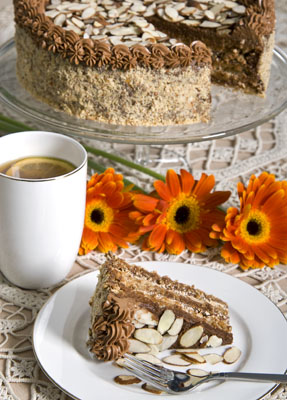
|
Crunchy Cake*
This classic 19th century French creation was my grandfather’s favorite. He loved both the wonderful taste of the chocolate and roasted almond combination, and the distinctive crunchy structure of the cake. Just a piece of this cake, along with a cup of coffee, would put him in a great mood. My grandmother new this, and she would strategically bake this cake at times when he got up on his left foot. This truly special cake consists of crunchy roasted almond meringue layers (dacquoise) filled with a thin layer of chocolate buttercream. Sounds simple, but almond lovers find it irresistible. Almonds can be substituted by walnuts or hazelnuts (or a combination of different nuts). The cake softens with time, and after three days melts in the mouth. I cannot decide which phase is better, I love it every way. |

|
Chocolate Caramel Cake*
This would have been a classical chocolate cake were it not for an extra twist of caramelized walnuts in its layers. This makes a world of difference for caramelized nuts lovers! Soft layers of sponge cake filled with finely grated caramelized walnuts spiced with cinnamon and lemon zest alternate with French chocolate buttercream filling. Piped out decoration adds an elegant finishing touch to the well rounded flavor. The cake can have either three or four thin layers. A four-layered version is baked in two pans and each layer is horizontally split into two thin layers to make a total of four layers. |
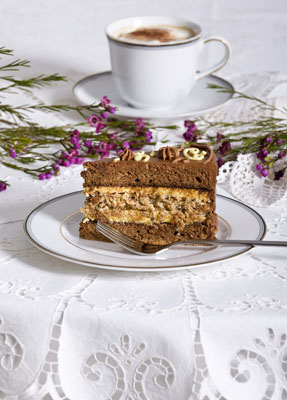
|
Catherine the Great Torte*
This torte bears the name of the famous Russian Empress Catherine the Great, who reigned from 1762 to 1796. Catherine’s rule re-vitalized Russia, which grew ever stronger and became recognized as one of the great powers of Europe. Most certainly, she could not have had this torte on her menu since many of the components of this torte came into being a century later. But many great cakes bear names of great people, and this cake is one of the greatest of them all. It looks very impressive once it is cut and its lovely interior exposed. What instantly distinguishes it from other cakes is its special middle layer made of crunchy roasted almond meringue. Upper and lower layers are classic dark chocolate sponge cake. It is filled with vanilla flavored French buttercream, iced with chocolate buttercream, and decorated with both. |

|
Dobos Torta*
Dobos torta is one of the most celebrated cakes of the world, and certainly the most famous Hungarian cake. It is composed of several (usually 5-7) thin layers of basic sponge cake filled with chocolate flavored French buttercream. Its impressive, shiny top is made of clear, amber-colored caramel glaze, marked into portions. With simple piped-out decoration along the edge, this cake is stunningly beautiful and elegant. Jozsef C. Dobos (1847–1924) was the greatest culinary authority in Hungary at the time, author of several cookbooks, celebrity chef, and owner of the most prestigious food specialty store in Budapest. Some sources claim that Dobos torta was introduced at the 1885 National General Exhibition in Budapest, where Austro-Hungarian emperor Franz Joseph I and his Empress Elisabeth were among the first to taste it. |

|
Bohemian Torte*
Although probably French in origin, the combination of dacquoise (nut meringue) and French buttercream spread quickly throughout the 19th century Europe. The term “bohemian”, also French in origin, was used in those days to describe the untraditional lifestyles of artists, writers, and actors in major European cities. It is associated with the free spirit, imagination, and creativity, all of which are needed to create this wonderful cake. So, unsurprisingly, it is called “Bohemian Torte”. Bohemian Torte is my favorite cake. It has two fillings layered on the top of each other, chocolate French buttercream, and vanilla pastry cream, spread between the three layers of roasted-nut-chocolate meringue. |

|
Rum Torte with Raisins*
Rum and raisins - what a classic combination of flavors. Still, it is very rarely seen in fine, layered cakes of Europe. It is not that raisins are not popular – on the contrary, they are a very common ingredient in breakfast pastries, cookies and everyday sweets. But somehow, raisins are not found in the finest of the cakes. This cake is an exception to that rule – it withstood the test of time and still remains a favorite special occasion cake. It is unusual, a little bit spicy, lovely to look at, and great to taste. It has moist sponge cake layers with finely grated walnuts spiced with a hint of lemon. Between them is a delicious chocolate pastry cream enriched with walnuts and rum-soaked raisins. All is topped with a thick, airy layer of Italian meringue made with caramelized sugar and dressed with chocolate shavings. Dark chocolate shavings with Italian meringue form a uniquely tasty combination on their own, and when combined with the other ingredients of this cake, the entire combination is truly hard to resist. |
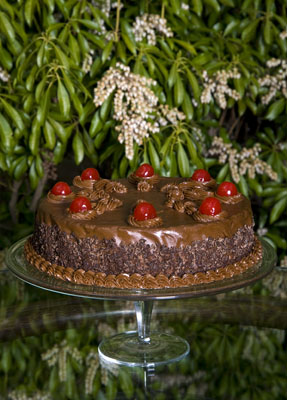
|
Swiss Chocolate Torte with Cherries*
This is the Swiss version of the Black Forest Cake. Sour cherries are embodied in a thick layer of wonderful chocolate mousse, sandwiched between chocolate sponge cake layers. This cake was one of my grandmother’s sour cherry specialties. It was the favorite of her late husband, which made it a must on the table for all important family gatherings. I really admired Grandmother’s cooking, and I was always wondering if it was for the love of cooking that she was not so much involved in another activity I thought all grandmothers were supposed to do: needlework. |

|
Divine Torte*
Somebody must have been very delighted with this cake to give it such a name! Cake layers are rich and moist walnut sponge with a hint of lemon zest. The filling between them is chocolate pastry cream spiced with roasted nuts. Airy top layer of Italian meringue nicely balances the rich foundation. The tradition of fine eating and drinking accompanied by the fine Viennese pastries and Austro-Hungarian layered cakes like this one, especially during celebrations, persists to the present in countries once dominated by the Austro-Hungarian empire and bordering the Danube River. |

|
Chocolate Torte with Raspberries*
Chocolate, coffee, rum and raspberries! It took me years to perfect this combination for my husband’s birthday cake, but the final success proved well worth the effort. As far as my husband is concerned, these is no cake in the whole world that can match the taste of this creation. There is something special about the French buttercream filling of this cake, its fusion of dark chocolate, rum and coffee, that my husband finds irresistible. The rest of the cake is carefully chosen to complement and accentuate the taste of the filling. It has two kinds of cake layers, basic light chocolate sponge on the outside, and creamy chocolate souffle in the middle, which is additionally layered with fresh raspberries. Their refreshing, subtle tartness gives it just the right amount of lift to raise this incredibly rich and creamy cake into the heavenly heights of pure, refined perfection. As my husband would say, a chocolate cake such as this warms even the coldest of hearts. |

|
History of Cakes and their Ingredients
Cakes, as we know them now, evolved gradually, from ancient times. Their basic ingredients -- eggs, flour, sugar, and butter -- were used for centuries. Yet the evolution of cakes as a part of the human food repertoire that is far from essential for survival, required more than mere ingredients. The history of cakes is directly entrained with the emergence of religious rituals, social ceremonies and celebrations that are meant to create an illusion of luxury and prosperity, an important element in consumption of luxurious food. That’s why the development of cakes closely tracked social and technological developments and the democratization of human society. |